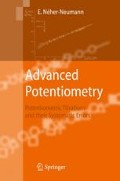In the previous chapters, equations have been derived for the estimation of the total potential anomalies and the preliminary data treatment for the equilibrium systems HY – BYz(B) – AyL – AY. In these calculations, the species Bz(B)+, Ly–, A+, Y– and H+ were assumed to be present. The potential functions Q(H, V)V with V = [Bz(B)+], [H+], [Ly–], \(\Delta\)cY or / and \(\Delta\)cA have been estimated, partly by conductivity measurements and partly by the use of known slope functions. Having these functions, log10 h can be calculated by successive approximations. Then preliminary chemical models and equilibrium constants can be established with the help of a curve-fitting computer program. From these results, one can see if the presence of the metal ion complexes is negligible or not. If they are not negligible, new treatment of emf data must be planned. This can take place through several steps.
Access this chapter
Tax calculation will be finalised at checkout
Purchases are for personal use only
References
Brönsted J N (1922) Studies of solubility. IV. The principle of the specific interaction of ions. J Am Chem Soc 44: 877-898. Calculation of the osmotic and activity functions in solutions of uni-univalent salts. J Am Chem Soc 44: 938--948.
Guggenheim E A (1966) Application of statistical mechanics. Clarendon press, Oxford.
Scatchard G (1936) Concentrated solutions of strong electrolytes Chem Revs 19: 309--327.
Guggenheim E A, Turgeon J C (1955) Specific interactions of ions. Trans Faraday Soc 51: 747--761.
Biedermann G (1975) Ionic media. In: Goldberg E D (ed) On the nature of sea water. Dahlem Konferenzen, Berlin. p. 339.
Spahiu K (1983) Carbonate complex formation in lanthanoid and actinoid systems. Dissertation. Kungliga Tekniska Högskolan, Stockholm.
Biedermann G, Bruno J, Ferri D et al. (1982) Modelling of the migration of lanthanoids and actinoids in ground water. The medium dependence of equilibrium constants. In: Lutze V W (ed) Scientific bases for radioactive waste management. 5: 791. Elsevier, New York.
Ciavatta L (1980) The specific interaction theory in evaluating ionic equilibria. Ann Chim (Rome) 70: 551--567.
Rossotti F J C, Rossotti H S (1961) The determination of stability constants and other equilibrium constants in solution. McGraw-Hill, New York.
Many publications of formerly Sillén L G. (1960–1971) Information about his works can be obtained: from Department of Chemistry / Inorganic Chemistry, Royal Institute of Technology (KTH), SE-100 44 Stockholm, Sweden.
Högfeldt E (1979) Graphic and computational methods in the determination of stability constants. In: Kolthoff I M, Elving P J (eds) In treatise on analytical chemistry, 2nd edn. Part I .2: 63 Wiley-Interscience, New York.
Meloun M, Havel J, Högfeldt E (1988) Computation of solution equilibria: a guide to methods in potentiometry, extraction and spectrophotometry. Ellis Horwood, Chichester, pp. 52--62.
Hietanen S, Sillén L G (1959) Studies on the hydrolysis of metal ions. 22. Equilibrium studies in self-medium: application to the hydrolysis of Th4+. ˙Acta Chem Scand 13: 533--550.
Ciavatta L, Ferri D, Grenthe I et al. (1981) Studies on metal carbonate equilibria 3. The Lanthanum(III) carbonate complexes in aqueous perchlorate media. Acta Chem Scand A53: 403--413.
Ingri N, Andresson I, Yagasaki A, Andresson L, Holmström K (1996) LAKE – A program system for equilibrium analytical treatment of multimethod data, especially combined potentiometric and Nuclear Magnetic Resonance data. Acta Chem Scand 50: 717--734.
Author information
Authors and Affiliations
Corresponding author
Rights and permissions
Copyright information
© 2009 Springer Science+Business Media B.V.
About this chapter
Cite this chapter
Neumann, E.N. (2009). Estimation of the Total Potential Anomalies and the Determination of the Equilibrium Constants in Emf Cells Where Every Kind of Complex Can Be Present. In: Advanced Potentiometry. Springer, Dordrecht. https://doi.org/10.1007/978-1-4020-9525-2_5
Download citation
DOI: https://doi.org/10.1007/978-1-4020-9525-2_5
Published:
Publisher Name: Springer, Dordrecht
Print ISBN: 978-1-4020-9524-5
Online ISBN: 978-1-4020-9525-2
eBook Packages: Chemistry and Materials ScienceChemistry and Material Science (R0)

